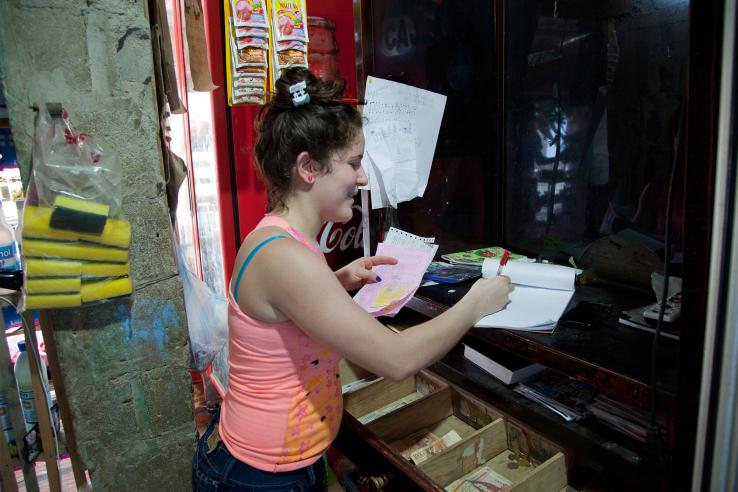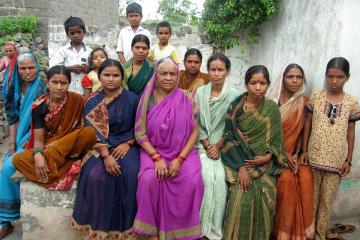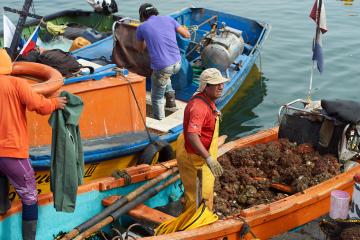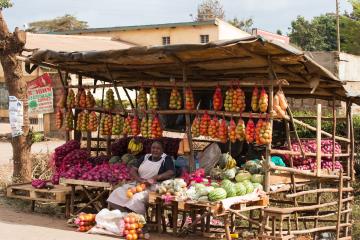Twitter recap: J-PAL and IPA’s financial inclusion Twitter chat

On October 31, J-PAL’s Finance Sector staff and IPA’s Financial Inclusion Program staff co-hosted a Twitter chat as part of the Center for Financial Inclusion’s Financial Inclusion Week (#FinclusionWeek). We invited people on Twitter to ask us anything about the evidence in financial inclusion, and we received questions on a range of topics.
For those who missed it, we’re recapping the conversation here so you can catch up and reference some of the resources we shared.
Nikkie asked about our work in the Philippines:
Dear @JPAL_Global and @poverty_action, what are past and current evaluations in the Philippines and SEAsia? #FinclusionWeek
— Nikkie Pacheco (@nikkiepacheco) October 31, 2017
.@nikkiepacheco: You can see financial inclusion evals in the Philippines here: https://t.co/a4qwhHrWtT
— J-PAL (@JPAL_Global) October 31, 2017
& SE Asia: https://t.co/tsrqIl1LaC https://t.co/bSRl6OoHTX
Hi, From the IPA side, we have quite a few https://t.co/LYqRKXY3M0
— IPA (@poverty_action) October 31, 2017
Village Enterprise and Giovanni asked about the evidence to support financial inclusion among disadvantaged populations. We responded with main takeaways and examples of studies that illustrate those concepts:
What evidence is there that #financialinclusion improves the livelihoods of the ultra poor? @JPAL_Global @poverty_action #FinclusionWeek
— Village Enterprise (@village_ent) October 31, 2017
Not randomized, but @SuriTavneet & Jack found M-PESA access improved lives of many https://t.co/AxNKxvDThq pic.twitter.com/JDLb9pBDaF
— IPA (@poverty_action) October 31, 2017
What type of financial products can improve the lives of people that don't have any financial inclusion?@JPAL_Global #FinclusionWeek
— Giovanni (@Giovanni___G) October 31, 2017
.@Giovanni___G In Kenya, access to savings accts helped women vendors increase savings, investments: https://t.co/sQlI3plcD1 #FinclusionWeek https://t.co/e60nIEELzY
— J-PAL (@JPAL_Global) October 31, 2017
We also received a couple of questions about digital financial services, including the dual role that technology can play in both widening and limiting access:
What role can fintech play in expanding access to credit in developing states? @JPAL_Global @poverty_action #FinclusionWeek
— David McDevitt (@davidwmcdevitt) October 31, 2017
.@davidwmcdevitt This paper summarizes #evidence and open q's in #fintech and access to credit: https://t.co/hdJmUrlZtL #FinclusionWeek https://t.co/5MBZPGmg4F
— J-PAL (@JPAL_Global) October 31, 2017
Here’s a paper summarizing existing evidence and open Qs: https://t.co/BFOhAHhjBe but in short promise for costs, but .../1
— IPA (@poverty_action) October 31, 2017
Also lots of risks for consumer protection https://t.co/mZ2WUSCwLp 2/2
— IPA (@poverty_action) October 31, 2017
Is focus on #digitalfinance widening gap btwn poor & v poor bc v poor don't have access to mobile tech? @JPAL_Global #FinclusionWeek https://t.co/2ZrC5MyNQ2
— Village Enterprise (@village_ent) October 31, 2017
Recent blog post by @nel_moore asks that q, specifically for women https://t.co/TVjj8Xgiyg
— IPA (@poverty_action) October 31, 2017
We had a lot to share about what happens when linking credit and insurance products:
The interaction between credit and insurance markets. What have you learned?
— Patrick (@patrickdoupe) October 31, 2017
.@patrickdoupe Some research has found that when demand for ins. is low, bundling can reduce demand for credit. Ex: https://t.co/TH1KtmDcU0 https://t.co/dXw7QHfQq3
— J-PAL (@JPAL_Global) October 31, 2017
.@patrickdoupe In Ghana, researchers tested if un-ins. risk or lack of capital was primary constraint to investment: https://t.co/Z1KTCzldDm https://t.co/dXw7QHfQq3
— J-PAL (@JPAL_Global) October 31, 2017
More info in the video here: https://t.co/U7PMNNaTqb #FinclusionWeek @poverty_action https://t.co/eKWI8IKoz4
— J-PAL (@JPAL_Global) October 31, 2017
Podcast version of it here https://t.co/6eY9pysaMZ
— IPA (@poverty_action) October 31, 2017
Village Enterprise had a few questions regarding savings models. Once again, we shared a review paper that covers the breadth of savings evidence and we highlighted some key examples:
Is there evidence that linking groups to banks increases savings & uptake of other services? @JPAL_Global @poverty_action #FinclusionWeek
— Village Enterprise (@village_ent) October 31, 2017
.@village_ent: Yes- this paper reviews the #evidence, shows there is generally demand for formal savings: https://t.co/FS8WhaDJpZ (p 40, 44) https://t.co/NF1ICKiMF4
— J-PAL (@JPAL_Global) October 31, 2017
.@village_ent: E.g., in Chile, access to formal savings self-reported well-being: https://t.co/NfNaKPyu3P #FinclusionWeek @dinapomeranz https://t.co/CacnWN7SQy
— J-PAL (@JPAL_Global) October 31, 2017
What about research comparing impact of savings models? E.g. VSLAs vs. table-banking? #FinclusionWeek @JPAL_Global @poverty_action
— Village Enterprise (@village_ent) October 31, 2017
Good q - we don't have a direct comparison. VSLAS improved some outcomes https://t.co/RPaX5HCnM7 but .... /1 pic.twitter.com/JEF7kRymP4
— IPA (@poverty_action) October 31, 2017
You'd expect a more flexible model to do better via @JMorduch @deankarlan https://t.co/32qF1Kt8o4 2/2 pic.twitter.com/ZP2jo984oz
— IPA (@poverty_action) October 31, 2017
We also shared evidence regarding group versus individual liability in microfinance:
What does the evidence say about group vs. individual liability loans? @JPAL_Global #FinclusionWeek
— Palesa Matlou Thinta (@Pulse225) October 31, 2017
.@Pulse225 Studies in the Philippines (https://t.co/AI7znEr4n8) & Mongolia (https://t.co/Q1sHmY5nZm) find no difference in repayment rates. https://t.co/njOysMXPNb
— J-PAL (@JPAL_Global) October 31, 2017
A question about tailored loan products generated a bit of discussion:
Is it advisable to design sophisticated microcredit programs for the poor? I.e.different conditions of term, amount, depending on activities
— Vanessa Carrera (@vanecarrera21) October 31, 2017
Given the data shows that microcredit alone isn't an effective poverty solution that would be a logical next step, BUT, when introducing /1
— IPA (@poverty_action) October 31, 2017
new versions of well-known fin products w/different terms, you want to be sure people have all the info - see @CGAP https://t.co/im1ZaDLmVP
— IPA (@poverty_action) October 31, 2017
.@vanecarrera21 More research is needed on this. Some evidence suggests positive impacts for borrowers… #FinclusionWeek (1/3) https://t.co/5ORd9uJskE
— J-PAL (@JPAL_Global) October 31, 2017
.@vanecarrera21 E.g. Studies in India found that flexibility benefitted borrowers, but slightly incr. defaults https://t.co/vnjuDQHGTh (2/3) https://t.co/QLCYCoagAU
— J-PAL (@JPAL_Global) October 31, 2017
.@vanecarrera21 And a study in Mali found ag. credit tailored for farmers’ cash flow increased ag. investment https://t.co/6XCf5JVyuM (3/3) https://t.co/4IuslShzlf
— J-PAL (@JPAL_Global) October 31, 2017
The value of loans to low-income HH's/firms do seem to vary with loan features. Beneficial improvements are likely to be costly to MFI's, so
— Elliott Collins (@elliottmcollins) October 31, 2017
it certainly seems advisable to experiment & stay responsive to client needs, but there are probably few free lunches in the credit sector.
— Elliott Collins (@elliottmcollins) October 31, 2017
Also, low collateral req's for Kenyan dairy farmers: https://t.co/fAoH6wpL6K; Flexible credit helped Zambias farmers https://t.co/yIoGqspRlF
— Elliott Collins (@elliottmcollins) October 31, 2017
We discussed challenges in implementing evaluations:
Single greatest challenge to evaluating impact (excluding the obvious) and any interesting ways @jpal & @poverty_action avoid this?
— Kevin Gomis (@kgomis83) October 31, 2017
Challenges are less in the evaluation itself, but finding willing partner who wants to experiment & has good admin data, & funder support.
— IPA (@poverty_action) October 31, 2017
And the evidence on microcredit:
Any evidence access to micro loans significantly raises economic activity for poorest? I've read its not a seachange but just a component.
— Nancy Wells (@only_visiting) October 31, 2017
.@only_visiting Microcredit evidence from 7 countries found incr. investment in business, but no change in profits: https://t.co/ClT96pwj0r pic.twitter.com/ajoUvEFw3A
— J-PAL (@JPAL_Global) October 31, 2017
@JPAL_Global Is there any evidence of the impact of microfinance at different levels of income or K assets?
— Pablo Monat (@PabloMonat) October 31, 2017
.@PabloMonat Some evidence suggests "hints of segmented transformative effects—good for some, bad for others” p. 3 https://t.co/G5Ch1gjNsH https://t.co/qCi0lhthLN
— J-PAL (@JPAL_Global) October 31, 2017
We also answered questions on other topics like financial education, energy, migration, and cryptocurrencies:
Where can we find evaluations of successful programs for financial education for entrepreneurs in the base of the pyramid?
— Vanessa Carrera (@vanecarrera21) October 31, 2017
Hi, See these in Dominican Republic: https://t.co/4dajSrcbPx & India https://t.co/1FxOnoppZi
— IPA (@poverty_action) October 31, 2017
.@poverty_action Any interesting findings re: intersection between energy poverty and financial inclusion? e.g. PAYG solar #FinclusionWeek
— Shanil Samarakoon (@shanilsam) October 31, 2017
Great q. @suritavneet & Billy Jack currently evaluating PAYG solar in Kenya: https://t.co/KhvFw47z5a #FinclusionWeek https://t.co/NarY3NmcXp
— J-PAL (@JPAL_Global) October 31, 2017
Jack & @SuriTavneet have one in progress https://t.co/J2DaCIfylV & we'd like to do more. But providers may learn lessons from /1
— IPA (@poverty_action) October 31, 2017
similar concepts structuring loans for rainfall storage tanks for farmers https://t.co/xcPdK0ZvCf 2/2
— IPA (@poverty_action) October 31, 2017
Kelsey Jack has work on pay-as-you-go electricity in Cape Town and the purchase patterns of the poor. #FinclusionWeek https://t.co/qpVwZEKggM
— Seema Jayachandran (@seema_econ) October 31, 2017
@JPAL_Global @poverty_action any effects of mobile financial services on migration? People not anchored to physical branch -> more mobility?
— Jamie Simonson (@JamieSimonson) October 31, 2017
.@JamieSimonson One recent RCT: https://t.co/91DWtUED5L. Regulation a challenge; @gatesfoundation working on it: https://t.co/0x8IW56MgP https://t.co/oA64jJOzWW
— J-PAL (@JPAL_Global) October 31, 2017
We haven't done anything directly related, but think you're on the right track, particularly remittances https://t.co/GBHkRehcz9 /1
— IPA (@poverty_action) October 31, 2017
And implications for family/network shared resiliency https://t.co/2SGp5u4L1y & https://t.co/kABCzH9I9f
— IPA (@poverty_action) October 31, 2017
Examples of real world use cases of using Blockchain CryptoCurrencies to improve Financial Inclusion? #FinclusionWeek @JPAL_Global
— Luis Miguel Abreu (@luis_abreu) October 31, 2017
Problem isn't so much moving money around/keeping it, as last mile - people still have to cash in/cash out of the system /1
— IPA (@poverty_action) October 31, 2017
And we're still figuring out local agent networks https://t.co/LOknFWLsJ7 2/2
— IPA (@poverty_action) October 31, 2017
Thanks to everyone who participated in this lively discussion! for more of the evidence in financial inclusion, visit our evaluation page.



